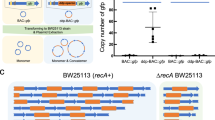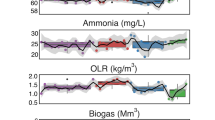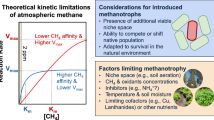Abstract
The role of soil methylotrophs in methanol exchange with the atmosphere has been widely overlooked. Methanol can be derived from plant polymers and be consumed by soil microbial communities. In the current study, methanol-utilizing methylotrophs of 14 aerated soils were examined to resolve their comparative diversities and capacities to utilize ambient concentrations of methanol. Abundances of cultivable methylotrophs ranged from 106–108 gsoilDW−1. Methanol dissimilation was measured based on conversion of supplemented 14C-methanol, and occurred at concentrations down to 0.002 μmol methanol gsoilDW−1. Tested soils exhibited specific affinities to methanol (a0s=0.01 d−1) that were similar to those of other environments suggesting that methylotrophs with similar affinities were present. Two deep-branching alphaproteobacterial genotypes of mch responded to the addition of ambient concentrations of methanol (⩽0.6 μmol methanol gsoilDW−1) in one of these soils. Methylotroph community structures were assessed by amplicon pyrosequencing of genes of mono carbon metabolism (mxaF, mch and fae). Alphaproteobacteria-affiliated genotypes were predominant in all investigated soils, and the occurrence of novel genotypes indicated a hitherto unveiled diversity of methylotrophs. Correlations between vegetation type, soil pH and methylotroph community structure suggested that plant–methylotroph interactions were determinative for soil methylotrophs.
Similar content being viewed by others
Log in or create a free account to read this content
Gain free access to this article, as well as selected content from this journal and more on nature.com
or
Accession codes
References
Alef K . (1991) Methodenhandbuch Bodenmikrobiologie: Aktivitäten, Biomasse, Differenzierung. Ecomed Verlagsgesellschaft: Landsberg/Lech.
Altschul SF, Gish W, Miller W, Myers EW, Lipman DJ . (1990). Basic local alignment search tool. J Mol Biol 215: 403–410.
Anesti V, Vohra J, Goonetilleka S, McDonald IR, Straubler B, Stackebrandt E et al (2004). Molecular detection and isolation of facultatively methylotrophic bacteria, including Methylobacterium podarium sp nov., from the human foot microflora. Environ Microbiol 6: 820–830.
Arfman N, Watling EM, Clement W, Vanoosterwijk RJ, Devries GE, Harder W et al (1989). Methanol metabolism in thermotolerant methylotrophic Bacillus strains involving a novel catabolic NAD-dependent methanol dehydrogenase as a key enzyme. Arch Microbiol 152: 280–288.
Atlas RM . (1993) Handbook of Microbiological Media. CRC Media: FL, USA.
Berg G, Smalla K . (2009). Plant species and soil type cooperatively shape the structure and function of microbial communities in the rhizosphere. FEMS Microbiol Ecol 68: 1–13.
Boden R, Thomas E, Savani P, Kelly DP, Wood AP . (2008). Novel methylotrophic bacteria isolated from the River Thames (London, UK). Environ Microbiol 10: 3225–3236.
Caparose JGKJ, Stombaugh J, Bittinger K, Bushman FD . (2010). QIIME allows analysis of high-throughput community sequencing data. Nat Met 7: 335–336.
Chistoserdova L . (2011). Modularity of methylotrophy, revisited. Environ Microbiol Rep 13: 2603–2622.
Chistoserdova L, Kalyuzhnaya MG, Lidstrom ME . (2009). The expanding world of methylotrophic metabolism. Annu Rev Microbiol 63: 477–499.
Conrad R . (2009). The global methane cycle: recent advances in understanding the microbial processes involved. Environ Microbiol Rep 1: 285–292.
Dedysh SN, Panikov NS, Liesack W, Grosskopf R, Zhou JZ, Tiedje JM . (1998). Isolation of acidophilic methane-oxidizing bacteria from northern peat wetlands. Science 282: 281–284.
Degelmann DM, Borken W, Drake HL, Kolb S . (2010). Different atmospheric methane-oxidizing communities in European Beech and Norway Spruce soils. Appl Environ Microbiol 76: 3228–3235.
Delmotte N, Knief C, Chaffron S, Innerebner G, Roschitzki B, Schlapbach R et al (2009). Community proteogenomics reveals insights into the physiology of phyllosphere bacteria. Proc Natl Acad Sci USA 106: 16428–16433.
Dixon JL, Beale R, Nightingale PD . (2011). Microbial methanol uptake in northeast Atlantic waters. ISME J 5: 704–716.
Donnelly MI, Dagley S . (1980). Production of methanol from aromatic-acids by Pseudomonas putida. J Bacteriol 142: 916–924.
Dufrene ML, Legendre P . (1997). Species assemblage and indicator species: the need for a flexible asymmetrical approach. Ecol Monogr 67: 345–366.
Dunfield PF . (2007). The soil methane sink. In: Reay DS, Hewitt CN, Smith KA, Grace J, (eds) Green House Gas Sinks. CABI: Wallingford, UK, pp 152–170.
Fall R, Benson AA . (1996). Leaf methanol—the simplest natural product from plants. Trend Plant Sci 1: 296–301.
Fedorov DN, Doronina NV, Trotsenko YA . (2011). Phytosymbiosis of aerobic methylobacteria: new facts and views. Microbiology 80: 443–454.
Fierer N, Jackson RB . (2006). The diversity and biogeography of soil bacterial communities. Proc Natl Acad Sci USA 103: 626–631.
Fischer M, Bossdorf O, Gockel S, Hansel F, Hemp A, Hessenmoller D et al (2010). Implementing large-scale and long-term functional biodiversity research: the biodiversity exploratories. Basic Appl Ecol 11: 473–485.
Galbally IE, Kirstine W . (2002). The production of methanol by flowering plants and the global cycle of methanol. J Atm Chem 43: 195–229.
Giovannoni SJ, Hayakawa DH, Tripp HJ, Stingl U, Givan SA, Cho JC et al (2008). The small genome of an abundant coastal ocean methylotroph. Environ Microbiol 10: 1771–1782.
Halsey KH, Carter AE, Giovannoni SJ . (2012). Synergistic metabolism of a broad range of C1 compounds in the marine methylotrophic bacterium HTCC2181. Environ Microbiol 14: 630–640.
Hektor HJ, Kloosterman H, Dijkhuizen L . (2002). Identification of a magnesium-dependent NAD(P)(H)-binding domain in the nicotinoprotein methanol dehydrogenase from Bacillus methanolicus. J Biol Chem 277: 46966–46973.
Holland MA, Long RLG, Polacco JC . (2002) Methylobacterium spp.: Phylloplane Bacteria Involved in Cross-Talk with the Plant Host?. APS Press: St. Paul, MN, USA.
Hung WL, Wade WG, Boden R, Kelly DP, Wood AP . (2011). Facultative methylotrophs from the human oral cavity and methylotrophy in strains of Gordonia, Leifsonia, and Microbacterium. Arch Microbiol 193: 407–417.
Jacob DJ, Field BD, Li QB, Blake DR, de Gouw J, Warneke C et al (2005). Global budget of methanol: constraints from atmospheric observations. J Geophys Res-Atmos 110 doi:10.1029/2004JD005172.
Kalyuzhnaya MG, Bowerman S, Nercessian O, Lidstrom ME, Chistoserdova L . (2005). Highly divergent genes for methanopterin-linked C1 transfer reactions in Lake Washington, assessed via metagenomic analysis and mRNA detection. Appl Environ Microbiol 71: 8846–8854.
Kalyuzhnaya MG, Chistoserdova L . (2005). Community-level analysis: genes encoding methanopterin-dependent enzymes. Environ Microbiol 397: 443–454.
Kalyuzhnaya MG, Hristova KR, Lidstrom ME, Chistoserdova L . (2008). Characterization of a novel methanol dehydrogenase in representatives of Burkholderiales: implications for environmental detection of methylotrophy and evidence for convergent evolution. J Bacteriol 190: 3817–3823.
Kalyuzhnaya MG, Lidstrom ME, Chistoserdova L . (2004). Utility of environmental primers targeting ancient enzymes: methylotroph detection in Lake Washington. Microb Ecol 48: 463–472.
Karl T, Harley P, Guenther A, Rasmussen R, Baker B, Jardine K et al (2005). The bi-directional exchange of oxygenated VOCs between a loblolly pine (Pinus taeda) plantation and the atmosphere. Atmos Chem Phys 5: 3015–3031.
Knief C, Ramette A, Frances L, Alonso-Blanco C, Vorholt JA . (2010). Site and plant species are important determinants of the Methylobacterium community composition in the plant phyllosphere. ISME J 4: 719–728.
Kolb S . (2009a). Aerobic methanol-oxidizing bacteria in soil. FEMS Microbiol Lett 300: 1–10.
Kolb S . (2009b). The quest for atmospheric methane oxidizers in forest soils. Environ Microbiol Rep 1: 336–346.
Lidstrom ME . (2006). Aerobic methylotrophic bacteria. In: Dworkin M, Falkow S, Rosenberg E, Schleifer K-H, Stackebrandt E, (eds) The Prokaryotes 3rd edn. pp 618–634.
Loew O . (1892). Ueber einen Bacillus, welcher Ameisensäure und Formaldehyd assimiliren kann. Centralblatt für Bakteriologie, Parasitenkunde, Infektionskrankheiten und Hygiene, Abteilung II 12: 462–465.
Lueders T, Wagner B, Claus P, Friedrich MW . (2004). Stable isotope probing of rRNA and DNA reveals a dynamic methylotroph community and trophic interactions with fungi and protozoa in oxic rice field soil. Environ Microbiol 6: 60–72.
McDonald IR, Bodrossy L, Chen Y, Murrell JC . (2008). Molecular ecology techniques for the study of aerobic methanotrophs. Appl Environ Microbiol 74: 1305–1315.
McDonald IR, Murrell JC . (1997). The methanol dehydrogenase structural gene mxaF and its use as a functional gene probe for methanotrophs and methylotrophs. Appl Environ Microbiol 63: 3218–3224.
McDonald IR, Radajewski S, Murrell JC . (2005). Stable isotope probing of nucleic acids in methanotrophs and methylotrophs: a review. Org Geochem 36: 779–787.
Mizuno M, Yurimoto H, Yoshida N, Iguchi H, Sakai Y . (2012). Distribution of pink-pigmented facultative methylotrophs on leaves of vegetables. Biosci Biotechnol Biochem 76: 578–580.
Naerdal I, Netzer R, Ellingsen TE, Brautaset T . (2011). Analysis and manipulation of aspartate pathway genes for L-lysine overproduction from methanol by Bacillus methanolicus. Appl Environ Microbiol 77: 6020–6026.
Nebel ME, Wild S, Holzhauser M, Huttenberger L, Reitzig R, Sperber M et al (2011). Jaguc—a software package for environmental diversity analyses. J Bioinformat Comput Biol 9: 749–773.
Neufeld JD, Schäfer H, Cox MJ, Boden R, McDonald IR, Murrell JC . (2007). Stable-isotope probing implicates Methylophaga spp and novel Gammaproteobacteria in marine methanol and methylamine metabolism. ISME J 1: 480–491.
Nojiri M, Hira D, Yamaguchi K, Okajima T, Tanizawa K, Suzuki S . (2006). Crystal structures of cytochrome cL and methanol dehydrogenase from Hyphomicrobium denitrificans: structural and mechanistic insights into interactions between the two proteins. Biochemistry 45: 3481–3492.
Nunn DN, Day D, Anthony C . (1989). The 2nd subunit of methanol dehydrogenase of Methylobacterium extorquens AM1. Biochem J 260: 857–862.
Quince C, Lanzen A, Davenport RJ, Turnbaugh PJ . (2011). Removing noise from pyrosequenced amplicons. BMC Bioinform 12: 38.
Radajewski S, Webster G, Reay DS, Morris SA, Ineson P, Nedwell DB et al (2002). Identification of active methylotroph populations in an acidic forest soil by stable-isotope probing. Microbiology 148: 2331–2342.
Ricke P, Kolb S, Braker G . (2005). Application of a newly developed ARB software-integrated tool for in silico terminal restriction fragment length polymorphism analysis reveals the dominance of a novel pmoA cluster in a forest soil. Appl Environ Microbiol 71: 1671–1673.
Romanovskaya VA, Stolyar SM, Malashenko YR, Dodatko TN . (2001). The ways of plant colonization by Methylobacterium strains and properties of these bacteria. Microbiology 70: 263–269.
Royston JP . (1995). Shapiro-Wilk normality test and P-value. Appl Stat 44.
Saitou N, Nei M . (1987). The neighbor-joining method—a new method for reconstructing phylogenetic trees. Mol Biol Evol 4: 406–425.
Schade GW, Solomon SJ, Dellwik E, Pilegaard K, Ladstätter-Weissenmayer A . (2011). Methanol and other VOC fluxes from a Danish beech forest during late springtime. Biogeochemistry 106: 337–355.
Schellenberger S, Kolb S, Drake HL . (2010). Metabolic responses of novel cellulolytic and saccharolytic agricultural soil Bacteria to oxygen. Environ Microbiol 12: 845–861.
Schink B, Zeikus JG . (1980). Microbial methanol formation—a major end product of pectin metabolism. Curr Microbiol 4: 387–389.
Schmidt S, Christen P, Kiefer P, Vorholt JA . (2010). Functional investigation of methanol dehydrogenase-like protein XoxF in Methylobacterium extorquens AM1. Microbiol-SGM 156: 2575–2586.
Segel IH . (1993) Enzyme Kinetics Behaviour and Analysis of Rapid Equilibrium and Steady-State Enzyme Systems. Wiley Classics Library: NY, USA.
Skovran E, Palmer AD, Rountree AM, Good NM, Lidstrom ME . (2011). XoxF is required for expression of methanol dehydrogenase in Methylobacterium extorquens AM1. J Bacteriol 193: 6032–6038.
Stralis-Pavese N, Sessitsch A, Weilharter A, Reichenauer T, Riesing J, Csontos J et al (2004). Optimization of diagnostic microarray for application in analysing landfill methanotroph communities under different plant covers. Environ Microbiol 6: 347–363.
Sy A, Giraud E, Jourand P, Garcia N, Willems A, de Lajudie P et al (2001). Methylotrophic Methylobacterium bacteria nodulate and fix nitrogen in symbiosis with legumes. J Bacteriol 183: 214–220.
Tamura K, Peterson D, Peterson N, Stecher G, Nei M, Kumar S . (2011). MEGA5: molecular evolutionary genetics analysis using maximum likelihood, evolutionary distance, and maximum parsimony methods. Mol Biol Evol 28: 2731–2739.
Ter Braak CJF, Smilauer P . (2002) CANOCO Reference Manual and CanoDraw for Windows User () s Guide: Software for Canonical Community Ordination (version 4.5). Micocomputer Power: Ithaca, NY, USA.
Trotsenko YA, Murrell JC . (2008). Metabolic aspects of aerobic obligate methanotrophy. Adv Appl Microbiol 63: 183–229.
Vorholt JA, Chistoserdova L, Stolyar SM, Thauer RK, Lidstrom ME . (1999). Distribution of tetrahydromethanopterin-dependent enzymes in methylotrophic bacteria and phylogeny of methenyl tetrahydromethanopterin cyclohydrolases. J Bacteriol 181: 5750–5757.
Warneke C, Karl T, Judmaier H, Hansel A, Jordan A, Lindinger W et al (1999). Acetone, methanol, and other partially oxidized volatile organic emissions from dead plant matter by abiological processes: significance for atmospheric HOx chemistry. Glob Biogeochem Cyc 13: 9–17.
Watanabe K, Hino S, Onodera K, Kajie SI, Takahashi N . (1996). Diversity in kinetics of bacterial phenol- oxygenating activity. J Ferment Bioeng Vol 81: 560–563.
Wellner S, Lodders N, Kämpfer P . (2011). Diversity and biogeography of selected phyllosphere bacteria with special emphasis on Methylobacterium spp. Sys Appl Microbiol 34: 621–630.
Acknowledgements
We thank the managers of the three Exploratories, Swen Renner, Sonja Gockel, Andreas Hemp, Martin Gorke and Simone Pfeiffer for their work in maintaining the plot and project infrastructure, and Markus Fischer, the late Elisabeth Kalko, Eduard Linsenmair, Dominik Hessenmöller, Jens Nieschulze, Daniel Prati, Ingo Schöning, François Buscot, Ernst-Detlef Schulze and Wolfgang Weisser for their role in setting up the Biodiversity Exploratories project. The study has been funded by the DFG Priority Program 1374 ‘Infrastructure-Biodiversity-Exploratories’ (DFG Dr 310/5-1), and the University of Bayreuth. Field work permits were issued by the responsible state environmental offices of Baden-Württemberg, Thüringen and Brandenburg (according to § 72 BbgNatSchG). We thank A Mustroph (Plant Physiology; University of Bayreuth) in advising how to grow sterile A. thaliana plants, R Daniel and coworkers (Göttingen Genomics Laboratory) for pyrosequencing of mxaF, mch and fae PCR products, and Ingo Schöning for providing total carbon and total nitrogen content data, and ammonium concentrations. The New Zealand Marsden Fund provided financial support for CKL (UOW1003).
Author information
Authors and Affiliations
Corresponding author
Additional information
Supplementary Information accompanies the paper on The ISME Journal website
Rights and permissions
About this article
Cite this article
Stacheter, A., Noll, M., Lee, C. et al. Methanol oxidation by temperate soils and environmental determinants of associated methylotrophs. ISME J 7, 1051–1064 (2013). https://doi.org/10.1038/ismej.2012.167
Received:
Revised:
Accepted:
Published:
Issue date:
DOI: https://doi.org/10.1038/ismej.2012.167
Keywords
This article is cited by
-
Exchange of volatile organic compounds between the atmosphere and the soil
Plant and Soil (2024)
-
Effects of drought and recovery on soil volatile organic compound fluxes in an experimental rainforest
Nature Communications (2023)
-
Methanol utilizers of the rhizosphere and phyllosphere of a common grass and forb host species
Environmental Microbiome (2022)
-
Impact of plants on the diversity and activity of methylotrophs in soil
Microbiome (2020)
-
Diazotrophic microbial community and abundance in acidic subtropical natural and re-vegetated forest soils revealed by high-throughput sequencing of nifH gene
Applied Microbiology and Biotechnology (2019)



